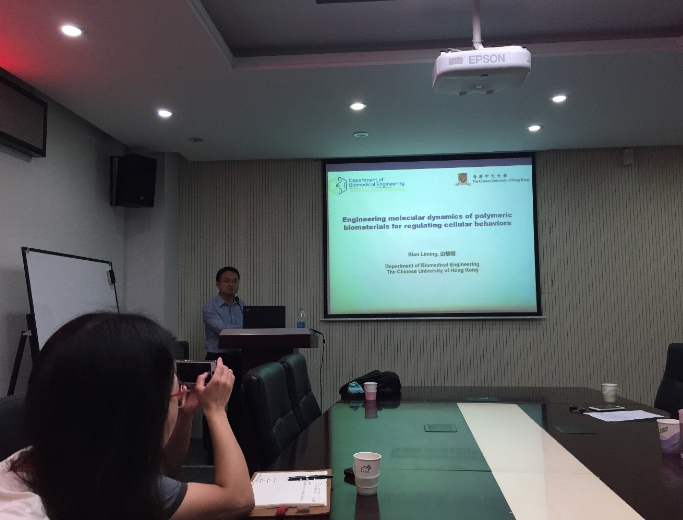
香港中文大学(The Chinese University of Hong Kong)边黎明教授于2018年7月16日到访并为必赢官网师生作了题为“Engineering the molecular dynamics of polymeric biomaterials for regulating cellular functions”的学术报告。
在此次报告中,边黎明教授重点介绍了以透明质酸为基础的超分子水凝胶体系在诱导间充质干细胞的分化及其调控细胞功能领域的研究进展。由于上述水凝胶体系具有较高的弹性和生物相容性,适宜细胞在水凝胶体系内的迁移与生长,可应用于胃溃疡模型的治疗。最后,在提问环节中,边黎明教授和在座师生进行了交流互动。
Biography
The dynamic properties of polymeric biomaterials at molecular level impart significant impact on the cellular behaviors. Developing tunable molecularly-dynamic biomaterials is highly instrumental to the fundamental investigation on cellular responses to the dynamic cues in extracellular environment. In particular, cellular adhesion is controlled by the dynamic ligation process of surface receptors, such as integrin, to adhesive motifs, such as Arg-Gly-Asp (RGD). Remote control of adhesive ligand presentation can offer benefits in regulating cell-implant interactions, thereby immune responses or tissue regeneration in vivo. Herein we present a strategy for modulating nanoscale ligand oscillations by adjusting the frequency of an oscillating magnetic field to modulate the adhesion and specialization of stem cells and macrophages. We grafted RGD ligand-bearing superparamagnetic iron oxide nanoparticles (SPIONs) to a substrate via a long flexible linker. We demonstrate that a low oscillation frequency of the magnetic field stimulated the adhesion and differentiation of stem cells as well as the adhesion and M2 polarization of macrophages in vivo. In stark contrast, a high oscillation frequency inhibited the adhesion and differentiation of stem cells and the macrophage adhesion, but promoted M1 polarization of macrophages in vivo. Our system offers the promising potential to manipulate cellular adhesion to implanted biomaterials and their function, such as inflammation or tissue repair.